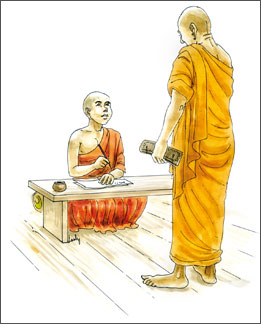The model more or less used in ancient Sri Lanka in its multilingual educational context reflects characteristics of the model called two-way bilingual education: teaching the same content in both languages: first in the known language and then in the target language with the use of ample supplementary material.
From the time of the King Dutugemunu the formal method of teaching followed by the Religion Ministries established throughout the country was composed of three stages in its procedure in Dhamma Desana according to Manorathapurani, the commentary to Anguttara Nikaya.
Buddhist monks were taught more than one language during ancient times
 At the first stage, a priest or an educated layman called Diva Katika Thera preached bana during the day time using mother tongue. Then the reciter of the words called ‘Padabhanaka’ explained the same, especially in relation to words/ vocabulary: this situation might have created the opportunity to explain semantically important aspects related to the concepts depicted in lexemes (vocabulary). Finally the Chief Preacher preached the Doctrine in detail: this third stage might have been the core of the lesson with theories (doctrine) supported by the first two stages which reflects the possibilities of understanding through language transfer.
At the first stage, a priest or an educated layman called Diva Katika Thera preached bana during the day time using mother tongue. Then the reciter of the words called ‘Padabhanaka’ explained the same, especially in relation to words/ vocabulary: this situation might have created the opportunity to explain semantically important aspects related to the concepts depicted in lexemes (vocabulary). Finally the Chief Preacher preached the Doctrine in detail: this third stage might have been the core of the lesson with theories (doctrine) supported by the first two stages which reflects the possibilities of understanding through language transfer.
In addition to using mother tongue mixing it in various percentages in the three stages of Damma Desana, it is possible to find evidence for using various other measures to enrich religious education through practices related to bilingual or multilingual education. Commentarial literature consisting three types of Sihalatthakatha is one among many such used at the beginning.
They were numerous parallel passages available in Sinhala to Pali Canon, and at the outset, mainly available as oral exegetical material in early Prakrit tradition in Sri Lanka.
They can be interpreted as adaptations which are used nowadays in bilingual education when localizing and appropriating learning contexts written in another language. These commentaries were first developed to explain the intricacies of the Buddhist doctrine during the life time of Arhath Mahinda himself’.
Samantapasadika mentions that there had been three types of Sihalaatthakata, Maha (Mula) Atthakatha. Maha Pacccari Atthakatha and Kurundi Atthakatha which are not physically available today since the time that Ven Buddhagosha had finalized his retranslations in Pali.
Source: www.dailynews.lk




